Discover the symbolic significance of moths in the Bible and how they reveal deep insights into impermanence and spiritual wealth.

Moths in the Bible
Have you ever considered why moths, seemingly insignificant creatures, are mentioned in the Bible?
As you explore their symbolic presence, you'll uncover a rich tapestry of meanings that extend beyond mere references to material decay.
The biblical narrative uses moths to illustrate prophetic warnings, the transient nature of earthly possessions, and the profound contrast between material wealth and spiritual riches.
This exploration might lead you to appreciate the nuanced way in which these creatures highlight themes of impermanence and humility.
Let's embark on this journey together, and you may find yourself viewing these nocturnal beings in a completely new light.
Key Takeaways
- Moths symbolize decay, impermanence, and the transient nature of material wealth in biblical texts.
- Their attraction to light represents the human quest for spiritual enlightenment and truth.
- Moths serve as a warning against materialism, urging a focus on spiritual rather than earthly values.
- In biblical prophecy, moths signify divine retribution and the vulnerability of human achievements to destruction and neglect.
Biblical Symbolism of Moths
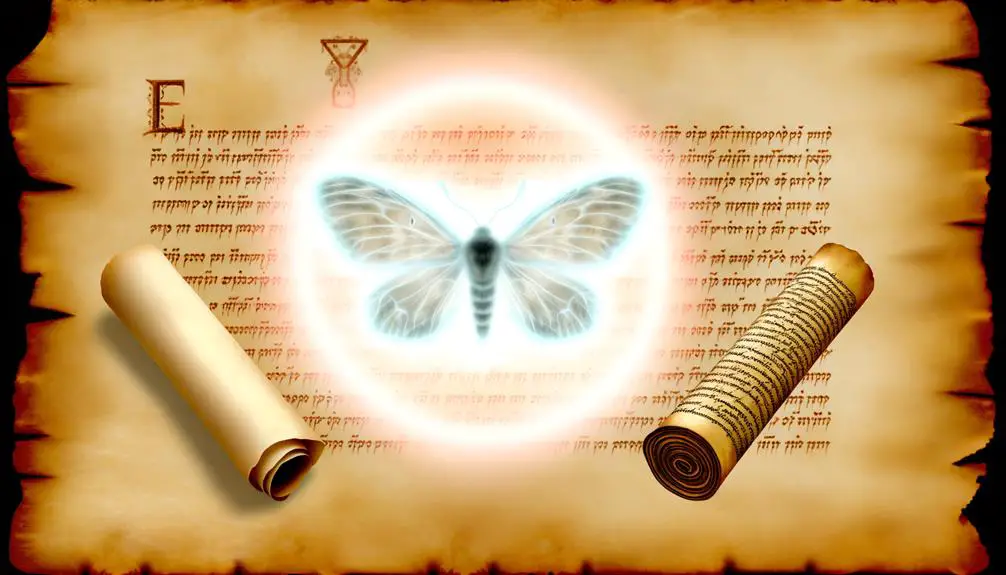
In biblical texts, moths symbolize impermanence and decay, reflecting on the fleeting nature of earthly possessions and the inevitability of physical deterioration. This symbolism is deeply intertwined with the natural characteristics of moths, particularly their metamorphosis and attraction to light, which serve as metaphors for transformation and the pursuit of enlightenment within a theological context.
Moth metamorphosis, a process that sees these creatures evolve from larvae to their final winged form, symbolizes the spiritual transformation believers are encouraged to undergo. Just as the moth undergoes significant change, you're reminded of the importance of spiritual renewal and the shedding of material concerns in favor of a more enlightened existence. This transformative journey isn't without its challenges but is essential for growth and development, mirroring the biblical narrative of redemption and salvation.
The moth's attraction to light further deepens its symbolic meaning. Just as moths are drawn to light, often at great risk to themselves, you're invited to consider the allure of spiritual enlightenment. This attraction, while fraught with potential peril, represents the inherent desire for truth and understanding that compels individuals to seek out the divine, even when it leads them through hardship.
Through these natural behaviors, moths embody the delicate balance between destruction and renewal, darkness and light. They serve as a powerful reminder of the transient nature of life and the enduring value of spiritual pursuit. As you delve deeper into the biblical symbolism of moths, you're encouraged to reflect on your own journey towards transformation and enlightenment, guided by the timeless lessons these creatures impart.
Moths and Material Decay
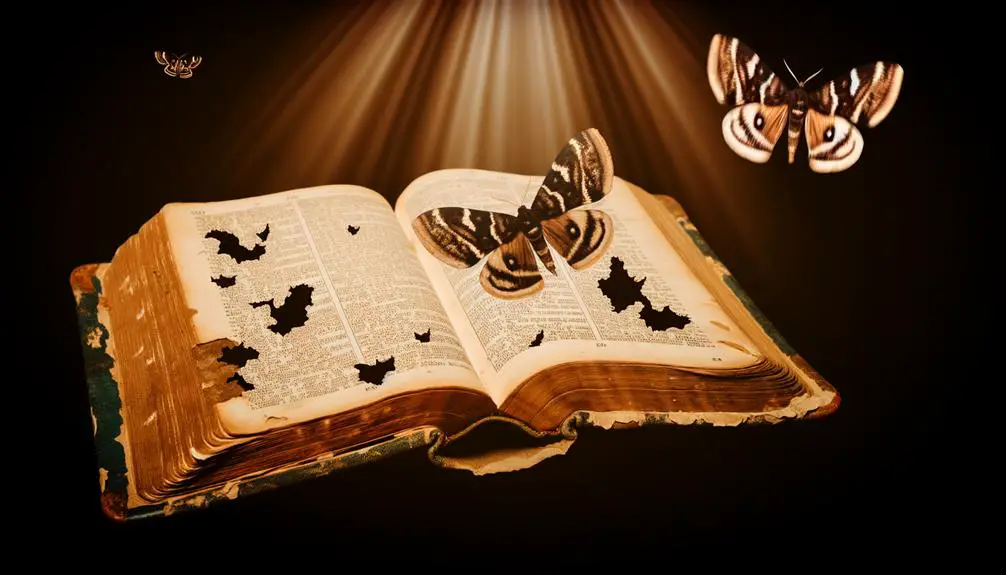
Why do moths, often seen as mere nuisances, hold profound significance in illustrating the inevitable decay of material possessions? This question beckons a deeper exploration into the relationship between moths and the degradation of textiles, a theme resonant with metaphorical and literal implications throughout historical and religious texts. Moths, by their very nature, consume and break down fibers in fabrics, serving as a stark reminder of the transitory nature of worldly goods.
In the realm of moth prevention and fabric care, understanding the lifecycle and habits of these insects is crucial. Moths are attracted to natural fibers such as wool, silk, and cotton, which contain keratin, a protein moths can digest. They prefer dark, undisturbed areas where their larvae can feed undetected. This predilection underscores the importance of vigilance in the storage and maintenance of valuable garments and textiles. Regular cleaning, the use of airtight containers, and the application of natural deterrents like cedar or lavender can mitigate the risk of moth damage.
The battle against moths extends beyond mere practicality; it embodies a broader philosophical reflection on the impermanence of material wealth. Just as moths silently consume and erode the integrity of cherished possessions, so too does time erode the perceived value and permanence of such items. This inevitable process of decay prompts a reevaluation of what's truly valuable, steering focus away from the material and towards the spiritual and intangible.
Prophetic Warnings and Moths
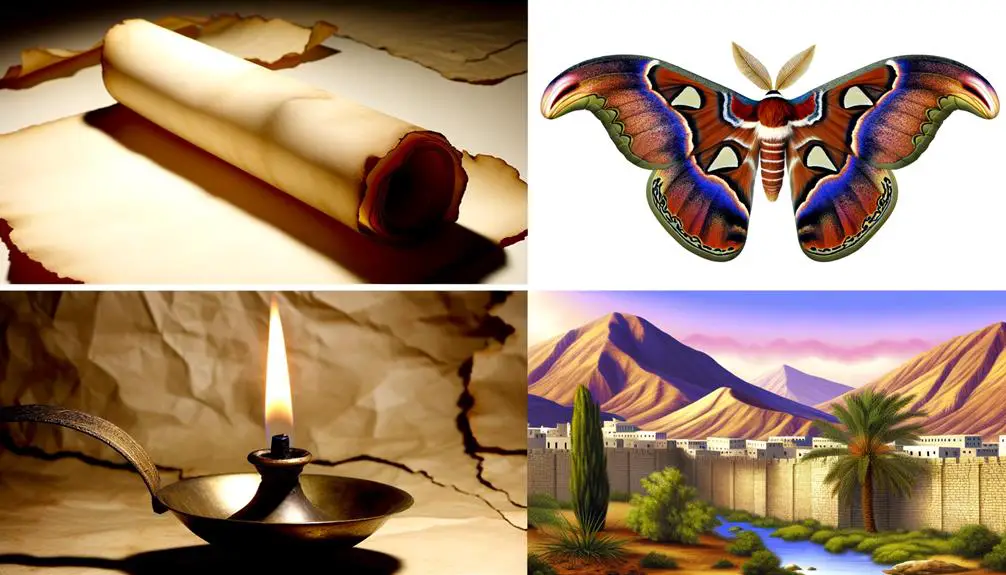
Reflecting on the impermanence of material wealth, it's essential to consider how biblical narratives use moths as symbols of prophetic warnings about the dangers of valuing the temporal over the eternal. Throughout the Bible, moths are depicted not just as agents of decay, but also as harbingers of divine messages, urging a shift in focus from earthly treasures to spiritual ones. This metaphorical use of moths serves as a poignant reminder of the fleeting nature of worldly possessions and the ultimate importance of spiritual enlightenment and eternal values.
The phenomenon of moth migration and their attraction to light can be paralleled to human tendencies to wander and be drawn to temporal desires, often ignoring the eternal light of spiritual truth. The Bible subtly uses these natural behaviors of moths to underscore the folly of being consumed by materialism and the inevitable decay of such pursuits.
Here's a breakdown of the symbolic use of moths in biblical narratives:
Aspect |
Symbolism |
Application |
|---|---|---|
Moth Migration |
Human tendency to stray |
Warning against spiritual complacency |
Light Attraction |
Drawn to temporal over eternal |
Encouragement to seek spiritual enlightenment |
Material Decay |
Impermanence of wealth |
Reminder of eternal values |
Prophetic Warnings |
Divine messages |
Urges focus on the spiritual |
Analyzing these elements reveals a deep, underlying message within the scriptures: the pursuit of material wealth is ultimately futile and transient. The biblical use of moths as symbols encourages a reevaluation of what is truly valuable, urging a shift towards spiritual fulfillment and eternal treasures.
Moths in the Old Testament

In the Old Testament, moths aren't merely insects but carry profound symbolic significance. You'll find that they're emblematic of decay and impermanence, particularly in the context of prophecy and warnings about material destruction.
The texts intricately associate moths with the inevitable degradation of earthly possessions, underscoring a thematic emphasis on the transient nature of material wealth.
Moths as Symbols
Throughout the Old Testament, moths emerge as potent symbols of decay and destruction, serving as a vivid illustration of the transient nature of earthly treasures and human endeavors. These creatures, undergoing moth metamorphosis, reflect the inevitable changes and ultimate decline of material possessions. Their attraction to light, meanwhile, can be seen as a metaphor for the often misguided human pursuit of ephemeral desires over eternal truths.
To understand the deeper meaning moths hold, consider:
- Moth metamorphosis symbolizes transformation and the fleeting nature of life.
- Light attraction highlights the dangers of being drawn to deceptive allurements.
- The destruction they cause serves as a reminder of the vulnerability and impermanence of worldly goods.
This symbolism encourages a reflection on values and the pursuit of what truly endures.
Moths in Prophecy
Moths, as depicted in Old Testament prophecy, serve as powerful omens of destruction and decay, forewarning of the inevitable downfall tied to earthly possessions and moral decay. This prophetic imagery, rich in metaphorical depth, underscores the transient nature of material wealth and the inherent vulnerability of human endeavors to the ravages of time and neglect.
The recurring theme of moth plagues not only exemplifies divine retribution but also reflects a broader, existential message about the impermanence of worldly achievements. Through this lens, moths transcend their literal existence, embodying a celestial warning against the folly of overindulgence and the neglect of spiritual welfare.
This nuanced portrayal invites a contemplative examination of values and priorities, urging a shift from the temporal to the eternal.
Destruction by Moths
Building on the symbolic representation of moths in biblical prophecy, the Old Testament vividly illustrates their role in actual events of destruction and decay, underscoring the tangible consequences of neglecting divine warnings. This narrative isn't merely historical but serves as an allegory for spiritual decay and the importance of vigilance in moth prevention.
- Moth prevention emphasizes proactive measures against spiritual and physical decay.
- Natural repellents symbolize the utilization of divine wisdom to deter corruption.
- The relentless nature of moths reflects the persistent threat of neglecting one's spiritual health.
This analysis reveals a deeper meaning, urging you to not only guard against physical moth infestations but to also apply spiritual diligence to prevent the decay of moral and ethical values.
New Testament References
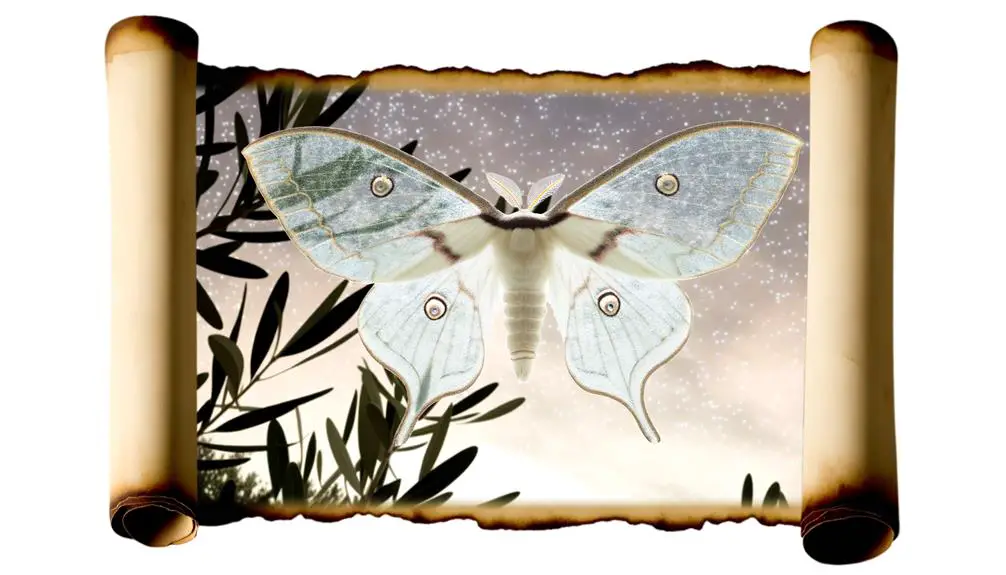
Shifting your focus to the New Testament, you'll notice that moths are imbued with rich symbolism, particularly in the context of Jesus' teachings.
These insects serve as a poignant metaphor for impermanence and the futility of earthly treasures, a theme that resonates deeply within the scriptures.
Exploring these references, you'll uncover the nuanced layers of meaning that moths carry, shedding light on their significance in biblical narratives.
Moths Symbolism Explored
In the New Testament, symbolism surrounding moths evolves, reflecting on their role as symbols of decay and impermanence in the material world. This shift in metaphorical significance is grounded in a deeper understanding of moth migration and nighttime imagery, offering a nuanced perspective on transient earthly treasures.
- Moth migration symbolizes the fleeting nature of material possessions, emphasizing the importance of focusing on spiritual wealth.
- Nighttime imagery associated with moths highlights the contrast between the darkness of worldly desires and the light of spiritual enlightenment.
- The impermanence of material goods, as represented by moth damage, serves as a poignant reminder of the enduring value of spiritual pursuits over temporal wealth.
These elements collectively underscore a profound biblical message about the transitory nature of the physical world and the lasting significance of spiritual devotion.
Jesus' Teachings on Moths
Reflecting on Jesus' teachings, it's evident that moths serve as a compelling metaphor for the transient nature of earthly riches in the New Testament. This imagery succinctly underscores the futility of hoarding material wealth, vulnerable to decay and destruction.
When analyzing Jesus' parables, one can't help but draw parallels between the behaviors of moths, particularly their attraction to light, and humans' gravitation towards fleeting treasures. This juxtaposition invites a deeper understanding of moth prevention not just in a literal sense but as a spiritual metaphor.
It encourages you to safeguard your soul from the corrosive effects of greed and to seek out the eternal light of spiritual wealth, which moths can't corrupt, nor thieves steal.
Impermanence and Spiritual Lessons

Moths, as depicted in biblical passages, serve as potent symbols of impermanence, urging you to contemplate the transient nature of earthly possessions and the enduring value of spiritual wealth. Their lifecycle, from the transformative moth metamorphosis to their innate attraction to light, encapsulates profound spiritual lessons that resonate deeply with the teachings of the Bible. Within this context, the moth's journey from larva to its final form parallels the spiritual transformation encouraged in believers, emphasizing the shedding of material concerns in favor of spiritual enlightenment.
The attraction of moths to light, meanwhile, symbolizes the pursuit of divine truth, a reminder that your focus should remain on the eternal light of God's wisdom, not the fleeting glimmers of worldly success. This analogy invites a deeper reflection on where you direct your attention and energies, advocating for a prioritization of spiritual over material pursuits.
Consider these insights:
- Moth metamorphosis as a metaphor for spiritual rebirth, highlighting the importance of evolving beyond superficial desires to embrace a deeper, more meaningful existence.
- Light attraction serves as a poignant reminder to seek out and follow the divine light, guiding your path through the darkness of earthly challenges.
- The ephemeral nature of moths, with their brief lifespan, reinforces the biblical message of life's fleeting nature, encouraging you to focus on accumulating spiritual wealth that transcends the physical realm.
In delving into the symbolism of moths in the Bible, you're invited to reflect on the impermanence of material possessions and the lasting value of spiritual growth and enlightenment.
Moths: Signs of Humility

Through their unassuming presence and simple form, moths embody humility, teaching you to value modesty over grandeur in your spiritual journey. Moth metamorphosis, from caterpillar to cocoon, and finally to moth, serves as a metaphor for the transformation of the soul. This process highlights the beauty of humble beginnings and the strength derived from simplicity. Cultural perceptions of moths, often overshadowed by their brighter butterfly relatives, further emphasize the virtue of humility. Moths don't seek the spotlight, thriving in the night's quietness, reminding you that true growth often happens in unseen places.
Analyzing moths through a biblical lens reveals their role as symbols of humility. Their lifecycle and behavior teach important spiritual lessons about the value of being modest and the strength found in quiet growth. Below is a table that contrasts moths with more conventionally admired creatures, reinforcing the importance of humility:
Feature |
Moths |
Butterflies |
|---|---|---|
Visibility |
Night dwellers, less noticed |
Day dwellers, widely admired |
Coloration |
Typically subdued, blending in |
Often vibrant, standing out |
Metamorphosis |
Quiet transformation |
Celebrated transformation |
Cultural Perception |
Associated with humility |
Often seen as symbols of beauty |
This comparison not only highlights the unique position of moths as emblems of modesty but also challenges you to rethink values. In a world that often celebrates the loudest and the brightest, the moth's journey encourages you to find strength in humility, recognizing that true transformation and growth can occur away from the public eye, in the quiet and the dark.
Earthly Gains Vs. Spiritual Riches
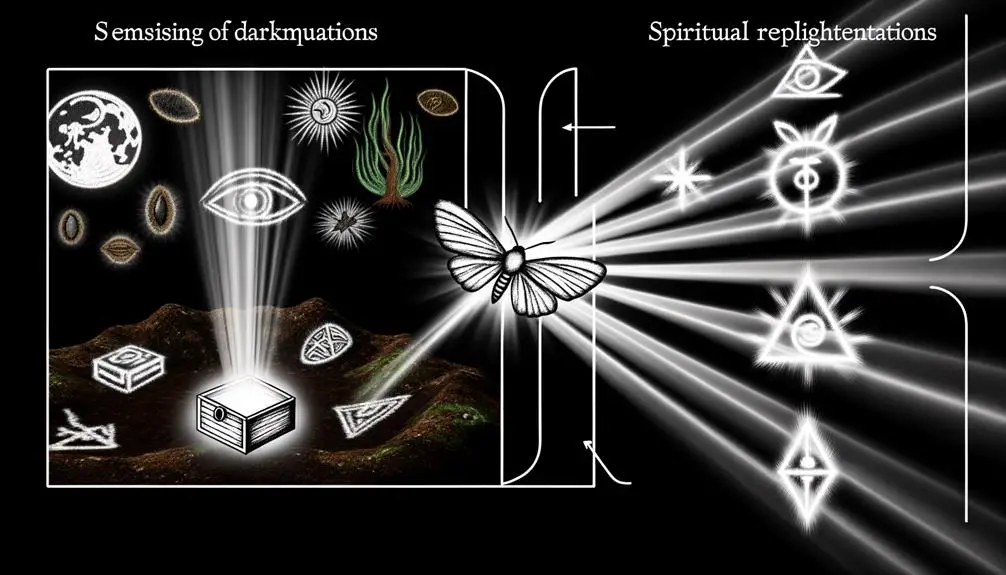
In evaluating the distinction between earthly gains and spiritual riches, you must consider the fleeting nature of material possessions compared to the enduring value of spiritual growth. The narrative of moths in the Bible metaphorically underscores this contrast, warning against the pitfalls of wealth accumulation and spiritual neglect. This cautionary tale prompts a deeper reflection on what truly holds value in one's life.
The pursuit of material wealth often leads to a paradoxical impoverishment, where the more one acquires, the greater the void felt within. This phenomenon isn't merely about physical possessions but extends to an overemphasis on status, power, and human approval. These pursuits, while momentarily satisfying, are susceptible to decay and destruction, much like the garments moths consume.
- Impermanence of Material Wealth: Everything you own or strive to own can be lost, stolen, or deteriorated. This impermanence questions the wisdom in placing one's ultimate value in what's inherently transient.
- Spiritual Neglect: Focusing solely on material accumulation often results in a neglect of spiritual development. The inner growth that fosters peace, contentment, and a sense of purpose is sidelined.
- Eternal Value of Spiritual Riches: Unlike material wealth, spiritual riches such as love, kindness, and wisdom aren't subject to decay. These virtues not only enrich your life but also positively impact those around you, creating a legacy that outlives material possessions.
Frequently Asked Questions
How Have Different Cultures Besides Those in the Bible Historically Interpreted the Presence or Symbolism of Moths?
Throughout history, moth mythology and cultural interpretations have varied widely. You'll find that in some traditions, moths symbolize transformation and adaptability, embodying the spirit of change. In others, they're seen as messengers from the spiritual world, guiding souls and revealing hidden truths.
Each culture adds a unique lens to understanding these creatures, weaving intricate narratives that go beyond mere appearances. Analyzing these interpretations, you'll uncover a rich tapestry of beliefs surrounding these enigmatic insects.
Are There Any Specific Types of Moths Mentioned in Biblical Texts, or Are Moths Referred to in a More General Sense?
When you delve into ancient texts, you'll find that specificity about moth species isn't their forte.
In the realm of biblical accuracy, moths are mentioned, but not in a way that entomologists would appreciate. They're referred to more in a symbolic sense, rather than by species.
This general approach leaves much to the imagination, prompting scholars and the curious alike to ponder the broader implications of these mentions without precise identification.
How Do Contemporary Theologians View the Symbolism of Moths in the Bible in Relation to Modern Environmental Issues?
You're diving into how contemporary theologians interpret moth symbolism in relation to today's environmental challenges. They often leverage moth metaphysics as a lens for ecological repentance, urging societies to reflect on their environmental impacts.
This scholarly analysis underscores a call for a deeper understanding of human actions on nature. By analyzing biblical symbolism, theologians advocate for a reevaluation of our ecological footprint, pushing for a more sustainable interaction with the world.
In Biblical Times, What Practical Methods Were Used to Protect Valuable Items From Moth Damage, and Do These Methods Have Any Spiritual Significance?
In biblical times, people used cedar storage and herbal repellents to protect their valuables from moth damage.
You'll find that cedar wood's natural oils deterred moths, while herbs like lavender and mint served as aromatic barriers.
These methods weren't just practical; they carried spiritual significance, symbolizing preservation and purity.
This dual purpose reflects a deeper understanding of the natural world and its integration into spiritual practices.
Can the Mention of Moths in the Bible Be Linked to Any Specific Historical Events or Periods Mentioned in Biblical Narratives?
You'd be intrigued to know that 80% of moths are nocturnal, a detail that enriches our understanding when we link their mention to historical events in biblical narratives.
Analyzing moth migration patterns offers insights into the timing and locations of these events. Symbolic interpretations further deepen our analysis, suggesting that moths, in their fleeting nature, could symbolize impermanence and decay, echoing themes prevalent in these ancient stories.
This approach offers a scholarly, detailed perspective.
Conclusion
In essence, moths serve as a profound biblical metaphor for the transient nature of worldly possessions and the imperative of spiritual wealth.
Consider the parable of the wealthy merchant who, upon discovering his finest garments ruined by moths, realized the futility of his material obsession. This narrative underscores the biblical admonition against placing undue value on earthly riches.
Moths, thus, not only symbolize decay but also offer a poignant reminder of the enduring value of spiritual investments over temporal gains.



Sign up